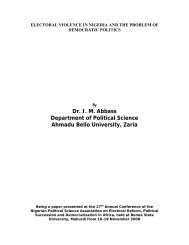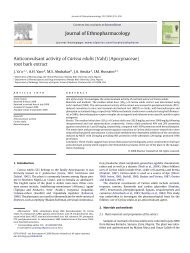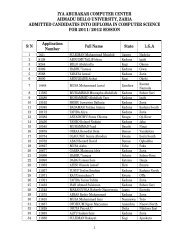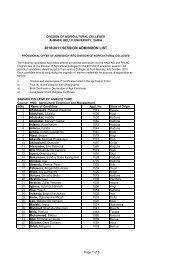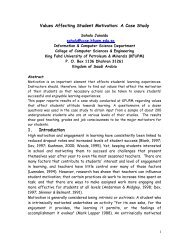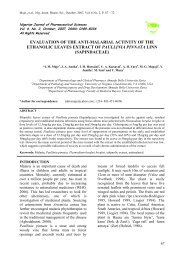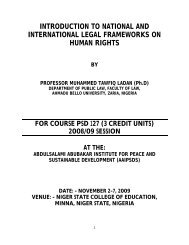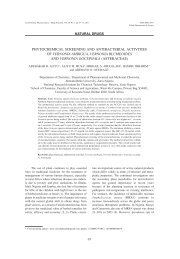ARSENIC LEVEL - Ahmadu Bello University
ARSENIC LEVEL - Ahmadu Bello University
ARSENIC LEVEL - Ahmadu Bello University
You also want an ePaper? Increase the reach of your titles
YUMPU automatically turns print PDFs into web optimized ePapers that Google loves.
114 Z. N. GARBA, S. A. HAMZA AND A. GALADIMAArsenic is an identified key contaminant (Eugene, 1979) for many decades that occurs in avariety of minerals including Arseno pyrite (FeAsS), Realgar (As2S2), Orpiment (As2S3),Arsenolite (As4O6), native Arsenic in ores of Copper, Lead, Cobalt, Nickel, Zinc, Silver, Tinand also as nickel glance (NiAsS) or mispickel (<strong>Bello</strong>, 1996; Garba et al. 2008). Arsenic ischemically very similar to its predecessor phosphorus, so much that it will partly substitute forit in biochemical reactions and is thus poisonous. When heated it rapidly oxides to arsenousoxide, which has a garlic odour. Arsenic and some arsenic compounds can also be sublime uponheating, converting directly to a gaseous form. Elemental arsenic is found in two solid forms;yellow and grey limetallic, with specific gravities of 1.97 and 5.73 respectively (Antman,2001).The toxic substance can be detected by several tests, including marsh test developed byJames marsh (Raymond, 1996; Garba et al; 2008). This test combines hydrogen formed by thereaction between zinc and sulphuric acid with the sample suspected to contain arsenic. If As2O3(which is poisonous) is present reacts with hydrogen to form toxic gas called arsine (AsH3),when arsenic gas is heated, it decomposes to form arsenic, which is recognized by its metallicluster (Raymond, 2005; Garba et aL, 2008). The most toxic of arsenic compounds are those inwhich the element lost all its three 4p electrons, that is when it exist in the +3 oxidation state(As 3+ ) (Leoschubert and Veguila, 1973; Garba et aL, 2008). One of the major mechanism bywhich Arsenic exerts its toxic effect is through an impairment of cellular respiration by inhibitionof various mitochondrial enzymes and the uncoupling of oxidative phosphorylation (Irogolic,1982; Garba et aL, 2008). The level of arsenic in natural waters varies between land 2mg/L(Welch et aL, 1988; Garba et aL, 2008). Concentrations may be elevated however, in areascontaining natural sources value as high as 12mg/L have been reported (Pumroy, 1980; Garbaet al., 2008).The current study reports a determination of mean arsenic concentration in drinking waterfrom Karaye Local Government Area, Kano State, Nigeria, with the aim to ascertain whetherthe level of arsenic contaminant in the drinking water is sufficient to cause health hazards to theinhabitants.EXPERIMENTALSample collectionWater samples were collected from three different types of water sources namely; Hand DugWells (HDW), Hand Pump Operated Boreholes (HPOB) and Tap Pumps (TP) randomly fromKaraye town, Sabongarin Karaye, Kwanyawa and Tudunkaya and were evenly spread. Boreholeswere operated for at least five minutes before sample collection. The samples were collectedin pre-cleaned plastic sample bottles and analyzed within one hour after collection.MaterialsIn preparation of reagents, BDH chemicals of analytical grade purity and distilled waterwere used. All weighings were carried out on analytical weighing balance (Gallenkamp MetlerModel H 3O). Standard solutions of iodine (0.1M to 0.0001M) and starch were prepared accordingapproved chemical procedures (Garba et al., 2008).Arsenic Concentration SpeciationThe speciation procedure considers both organic and inorganic Arsenic to exist as initialAs 2O 3species that are equally available to the iodine molecules (Garba et al., 2008). 25cm 3 ofeach water sample was pipetted into a 250cm 3 conical flask and a spatula full of sodium bicar-
<strong>ARSENIC</strong> <strong>LEVEL</strong> SPECIATION IN FRESH WATER FROM KARAYE... 115bonate was added followed by the addition of a 3 to 4 drops of starch indicator. The resultingsolution was titrated against 0.0001M iodine solution to the first appearance of deep blue colourwhich marked the end point. The experiment was repeated 3 times within each sample.Equations of the reaction :As 2O 3+2I 2+2H 2O →As 2O 5+4H + + 4FDetermination of pHThe pH of the well water samples were determined using digital pH meter (Model PV/mVmeter, 8519N). The meter was calibrated for 15 minutes and further standardized withreference buffer solution of pH 7,00. The electrode of the meter was thoroughly rinsed withdistilled water and inserted in the sample solution. The pH values of the samples were digitallyrecorded accordingly.Results and DiscussionAs earlier indicated, twenty different samples of drinking water collected from the studyareas were analyzed. Table-1 reports the results for all the water samples analyzed showing themean arsenic concentration (mg/L) and the pH values for each sampling unit.Table-1 : Arsenic concentrations and mean pH values of drinking waterfrom Karaye local Government Area, Kano State.S/No. Location Source Mean As conc. (mg/L) Mean pH1 Karaye TP 0.16 6.892 Karaye TP 0.10 7.003 Karaye TP 0.14 7.444 Karaye HPOB 0.12 7.455 Karaye HPOB 0.16 7.436 Karaye HDW 0.56 7.437 Karaye HDW 0.60 7.428 Karaye HDW 0.56 7.009 Karaye HDW 0.40 7.4410 Karaye prow 0.50 7.4311 S/Karaye prow 0.47 7.4212 S/Karaye HDW 0.51 7.4313 S/Karaye TP 0.09 7.4414 Kwanyawa prow 0.40 7.4515 Kwanyawa PIPOB 0.12 7.4216 Kwanyawa prow 0.39 7.4717 Kwanyawa HDW 0.52 7.4818 TYKaya PIPOB 0.25 6.9219 T/Kaya PIPOB 0.27 7.4420 T/Kaya prow 0.51 7.43HDW-Hand Dug wells, HPOB-Hand Pump Operated Boreholes, TP-Tap Pumps, S/karaye-Sabongarin karaye and T/kaya-Tudun Kaya.The pH levels obtained from the analysis as illustrated in table-1 were found to vary from6.89 to 7.48 for all the samples analyzed. All the values showed good agreement with WorldHealth Organization recommended limit (6.5 to 9.5) for fresh drinking water. This could bepossibly attributed to the geological setting of the study area, indicating no historically detectableelevated levels of either acidic or basic solute contaminants (Garba et al., 2008).
116 Z. N. GARBA, S. A. HAMZA AND A. GALADIMAOn the other hand, high concentrations of arsenic were recorded in all the samples whencompared with WHO maximum permissible limit of O.Olmg/L of drinking water. The HandDug Wells were found to contain higher concentration of Arsenic with 0.60mg/L the highestfrom Karaye town. This might be associated with deepness of the wells (usually more than 20mbut less than 100m deep), human activities in the area were the samples were collected andpossibilities of impurities getting into the wells due to permanent ventilation.Lowest concentration was observed from the tap pumps (0.09mg/L) of Sabongarin Karaye.This indicates a decreased in concentration resulting from pre-supply treatments. Samples fromthe Boreholes are also lower than that of Hand Dug Wells but slightly more than that of the TapPumps even though greater than 0.0lmg/L set by WHO and Standard Organization of Nigeria(SON). This is due the deepness of the Boreholes (usually more than 100m deep), impossibilityof impurities getting into the Boreholes and geological survey usually conducted before sitingsuch wells. Arsenic concentrations in water depends much on source of arsenic contaminationwhich may be as a result of natural processes, industrial or agricultural activities and increase inhuman activities in the area where the wells are located. Different works have been reported bymany researchers on arsenic concentrations in well water. Musa et al., (2008) reported a meanarsenic concentration of 0.0.2 to 0.51mg/L in Zaria city. Garba et al, (2008) reported higharsenic concentration of 0.809mg/L in Kutama and 0.765mg/L in Getso, Gwarzo Local Governmentarea, Kano State. All of which are above the allowable limit of 0.0lmg/L. They attributedthese high concentrations to disposal of arsenic containing materials, burning of solidwastes, natural processes, industrial activities and other human activities (Garba et al., 2008;Musa et al., 2008). Generally, high arsenic species concentration are recorded in the samples,especially from the wells because of their open settings and the areas where they are locatedhost many anthropogenic activities coupled with historic undersurface weathering and surfacechanneling and gully erosion.ConclusionCombined organic and inorganic Arsenic concentrations speciation in drinking water fromKaraye Local Government area, Kano state revealed high levels greater than the maximumpermissible limit sets by the World Health Organization (O.Olmg/L) and hence, the watersamples are not fit for human consumptions. People that are prominently consuming the waterfrom these areas are vulnerable to arsenic related diseases such as; cardiovascular problems,convulsions, inflammation of the liver, cancer, birth defects, organ damage disorder of thenervous system and damage to the immune system. Considering the associated risks, we recommendKano State government to ensure that all sources of drinking water are adequately treatedto make them fit for human consumption. In the local areas where Hand Dug Wells serve as theonly source of fresh water, improved water supply should be provided and the wells properlyprotected from all sources of contaminants.REFERENCES<strong>Bello</strong>, C.F. and Lott, K.A.K. (1996): Modern Approach to Inorganic Chemistry,MacmillanPress, 210<strong>Bello</strong>, M. (1995): Different method of water analysis. A thesis submitted to the Faculty ofScience, Usmanu Danfodiyo <strong>University</strong>, Sokoto. Department of Chemistry pp 2-4.Clean Water Act (1972): [Retrieved July 16, 2009], from: Wikipedia, the free encyclopaedia.Denloye, S.A. (2004): Quality Parameters from packed water. NAFDAC Laboratory experience.IP AN News.Eugene, M. (1979): Introduction to Modern Chemistry, ELBS. London, Pp 132.Food and Agricultural Organisation(FAO, 2007): Coping with water scarcity, 2007 World Wa-
<strong>ARSENIC</strong> <strong>LEVEL</strong> SPECIATION IN FRESH WATER FROM KARAYE... 117ter Day, 22 nd March, 2007. Available on 127 017 2010 from: http://www.fao.org/nr/water7docs/wwd07brochure.pdfGarba, Z.N., Gimba, C.E., Hamza, S.A and Galadima, A. (2008): Tetrimetric determination ofarsenic in well water from Getso and Kutama, Gwarzo Local Government Area, Kanostate, Nigeria Chem class journal, vol. 5, pp78-80.Grund, S.C., Hanusch, K., and Wolf, H.U. (2008): “Arsenic and Arsenic Compounds” inUllmann’s encyclopaedia of industrial chemistry, VCH-Wiley, 2008 Weinhein [RetrievedJuly 16, 2009], from: Wikipedia, the free encyclopaedia.Hossain M.F (2006): “Arsenic contamination in Bangladesh. An overview”. Agriculturalecosystem and Environment 113(1-4): 1-16.doil0.1016/j.agee.2005.08.34(http:dx.doi.org/10.1016/j.agee.2005.08.34Irogolic, K.J (1982): speciation of arsenic compounds in water supplies. Research TrianglePark, NUGs Environmental Protection Agency (EPA-600151-32-010)Jansen, M. (1977): “Crystal Structure of As 2O 5”. Angewandte Chemie International edition inEnglish 16(5):314-315. [Retrieved July 16, 2009], from: Wikipedia, the freeencyclopaedia.Leochubert, L..A and Veguila B. (1973): Chemistry and Society, Allyn and Bacon Inc. 253-255.Musa, H., Yakasai, LA., Musa, K.Y. Isah, A.B. and Mshelbwala, K. (2008): J.AppLSci., 8(11):2183-2186Mustapha, S. (1999): Physiochemical Analysis of Raw and Treated Water. A thesis submitted tothe Faculty of Science, Usmanu Danfodiyo <strong>University</strong>, Sokoto Department of Chemistrypp 613.National Institute for Occupational Safety and Health. Emergency Response Safety and HealthDatabase (2008): Arsenic Pentoxide Systemic Agent. [Retrieved July 16, 2009], from:Wikipedia, the free encyclopaedia.Raymond, C. (1996): General Chemistry, The Essential Concept, McGraw Hill, 90Raymond C (2005): General Chemistry, eight edition, McGraw Hill, P. 160Schueler, T.R. (2002): “Microbes and Urban Watersheds. Concentrations, sources and pathways.[Retrieved July 16, 2009], from: Wikipedia, the free encyclopaedia.Seth H., Olega F.R. Maynard M.D. and Sarkar B. (2002): The concentration of arsenic andother toxic elements in Bangladesh drinking water. Environ. Health, 110(111); 1142-1153Standard Organisation of Nigeria (SON) (2003): Inorganic Constituents for Drinking WaterQuality.Uduma, U.A. (2008): Quality of Sachet Water in Kano Metropolis. A M.Sc. Thesis, ChemistryDept, BUK. p62United States Environmental Protection Agency (EPA) Washington, DC (2002): “The NationalWater Quality Inventory: Report to congress for the 2002 reporting cycle-Aprofile.[Retrieved July 16, 2009], from: Wikipedia, the free encyclopaedia.United States Geological Survey (USGS) (1998): Denver, co. “Ground Water and Surfacewater. A Single Resources. [Retrieved July 16, 2009], from: Wikipedia, the freeencyclopaedia.Welch, A.H., Lico, M.S and Hughes, J.L (1988): Arsenic in ground water of the WesternUnited States. Ground water, 26:333-347.World Health Organization (WHO) (1999): Guidelines for Drinking Water Quality Recommendations.(2 nd ed.) vol.1. Delhi: AITBS Publishers.World Health Organization (WHO) (1999): Surveillance of drinking water quality. Geneva:WHO publications.


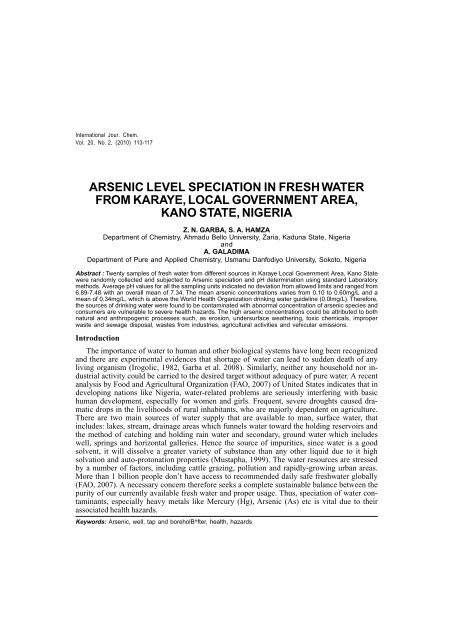
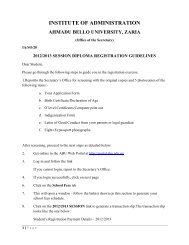
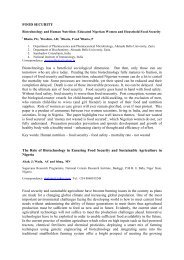

![Full Paper [PDF]](https://img.yumpu.com/49740055/1/184x260/full-paper-pdf.jpg?quality=85)
